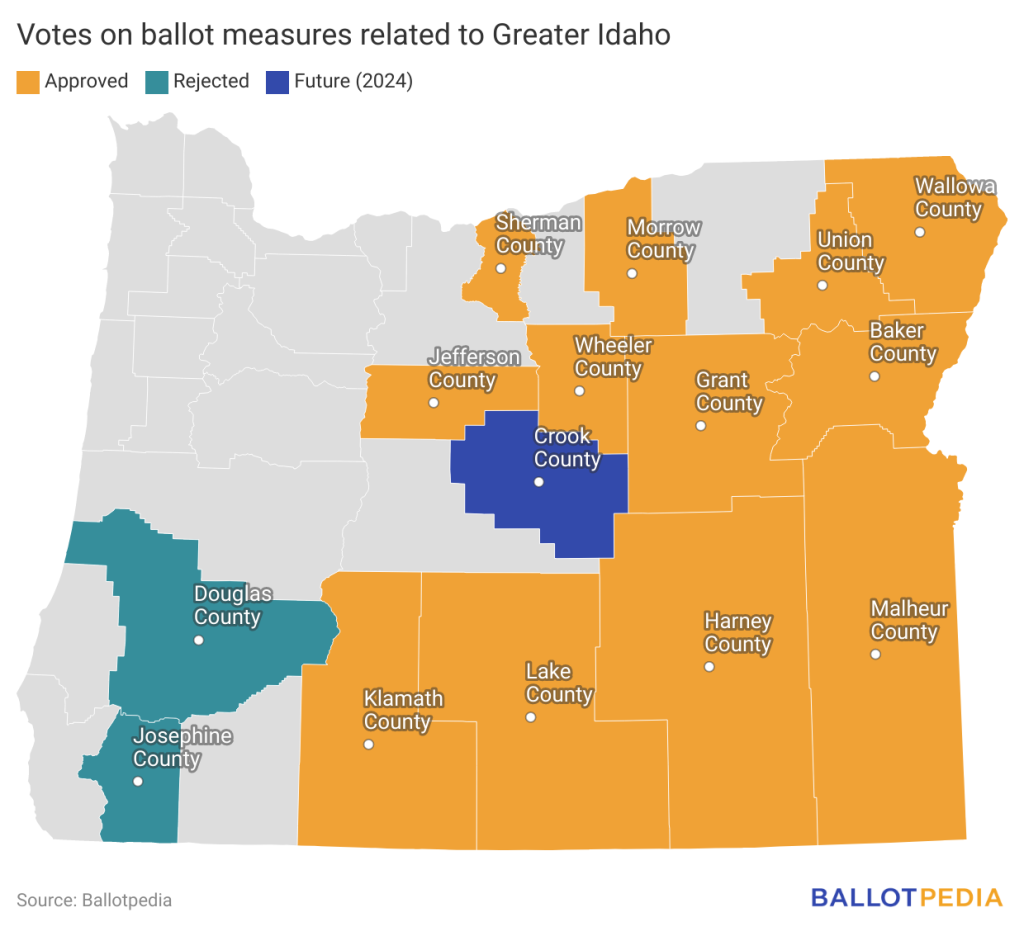In eastern Oregon, voters in 12 counties have approved ballot measures between 2020 and 2023 that propose seceding from the state and joining neighboring Idaho. Supporters refer to this effort as Greater Idaho.
Since 2020, there have been 16 countywide ballot measures on Greater Idaho in Oregon.
- Voters approved ballot measures in 12 counties—Baker, Grant, Harney, Jefferson, Klamath, Lake, Malheur, Morrow, Sherman, Union, Wallowa, and Wheeler.
- Voters rejected ballot measures in two counties—Douglas and Josephine.
- Douglas County and Wallowa County have voted on ballot measures twice. Voters in Douglas County rejected measures in 2020 and 2022. Voters in Wallowa County rejected a measure in 2020 before approving a measure on May 16, 2023.
Voters in Cook County, Oregon, will decide on a ballot measure related to Greater Idaho on May 21, 2024.
Of the 16 countywide ballot measures, the average vote was 55.85% ‘Yes’ to 44.15% ‘No’. The highest approval was in Lake County, Oregon, where an initiative received 74.64% in 2021, and the lowest approval was in Douglas County, Oregon, where a measure received 43.32% in 2020 (the second time Douglas County voters decided a measure, the question received 47.37%).
The ballot measures themselves cannot cause counties to join Idaho. Rather, the ballot measures were written as non-binding questions or as ordinances requiring Boards of Commissioners to hold meetings on Greater Idaho or advocate for moving the state’s borders.
Changing the state boundaries of Oregon and Idaho would require approval from the U.S. Congress and state legislatures of Oregon and Idaho, per the U.S. Constitution, Article I, Section 10, and Article IV, Section 3.
In 2023, Oregon Sen. Dennis Linthicum (R-28) introduced Senate Joint Memorial 2 (SJM 2), which did not receive a vote. SJM 2 would have resolved that “eastern Oregonians have begun to see Oregon government as a threat to the livelihoods, liberties and values of their communities” and that legislators were “ready to begin discussions regarding the potential to relocate the Oregon/Idaho border.” Idaho, the House of Representatives passed a memorial in February 2023 that said, “the Idaho Legislature stands ready to begin discussions with the Oregon Legislature regarding the potential to relocate the Oregon/Idaho state boundary, in accordance with the will of the citizens of eastern Oregon, and we invite the Oregon Legislature to begin talks on this topic with the Idaho Legislature.” The Senate did not vote on the memorial.
Supporters of Greater Idaho have said that divisions exist between eastern and western Oregon. Matt McCaw, a spokesman for the Greater Idaho Movement, said, “Eastern Oregon is culturally, politically, economically much more similar to Idaho than it is to western Oregon. Our movement is about self-determination and matching people to government that they want and that matches their values. In Oregon, we’ve had this urban-rural divide for a very long time.” Mark Simmons (R), the former Speaker of the Oregon House of Representatives (2001-2003), supports the effort. He said the move would also benefit Idaho. “Idaho would have the satisfaction of freeing rural, conservative communities from progressive blue-state law. We are dismayed by the manner in which Oregon’s government has marginalized our values and villainized our resource-based livelihoods,” said Simmons.
Gov. Tina Kotek (D) responded to the ballot measures, saying, “I think there are a lot of Oregonians who are frustrated and don’t feel heard. That, I think, is what the movement is about. I want to be partners across the border. We have things that we will solve together and I’m hoping through dialogue and conversation, we can address frustrations and concerns and move forward as one state.” Shelley Wyllie, a member of Oregon Together in Grant County, said, “[T]he Greater Idaho movement has kind of descended in with a solution that has appealed to certain people. And I think they have not given much thought to the consequences of what that would mean for their families, their lifestyle in this part of Oregon and what Oregon actually provides for them.”
Supporters of creating new states or changing state boundaries have used local countywide ballot measures in the past. In 2013, 11 counties in Colorado voted on forming a 51st state, called North Colorado. Six counties approved the measures. In California, there have been countywide ballot measures about forming the State of Jefferson. Like Greater Idaho, those efforts would require state and federal legislative approval, which has not occurred. Unlike Greater Idaho, those efforts were to create new states, rather than moving state boundaries—a difference that the Greater Idaho Movement has highlighted.








